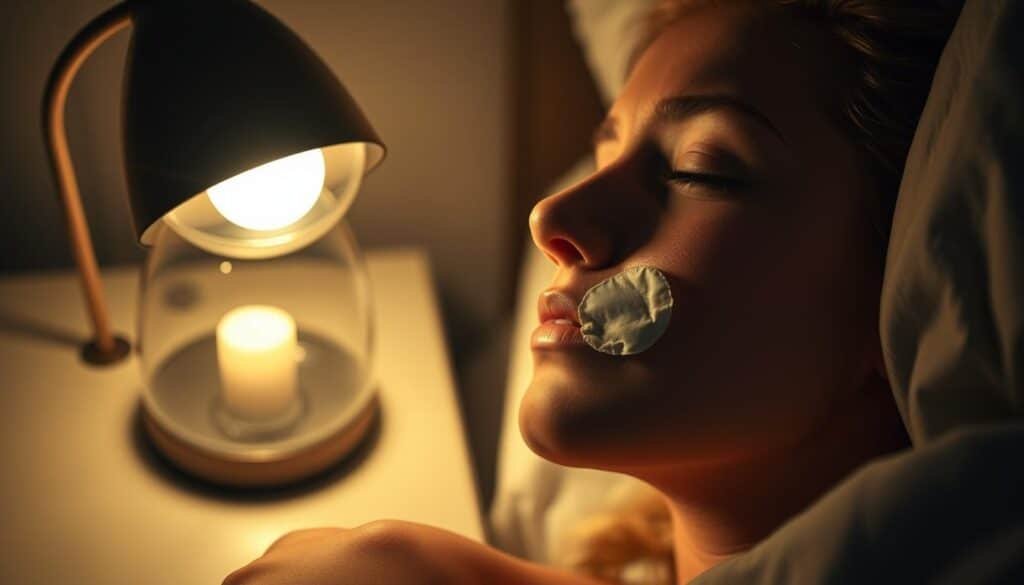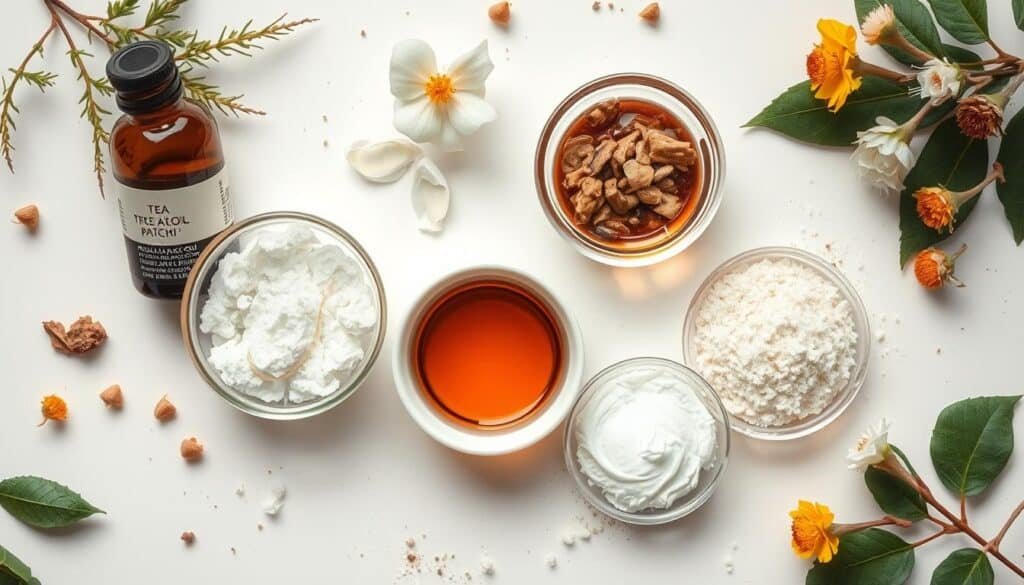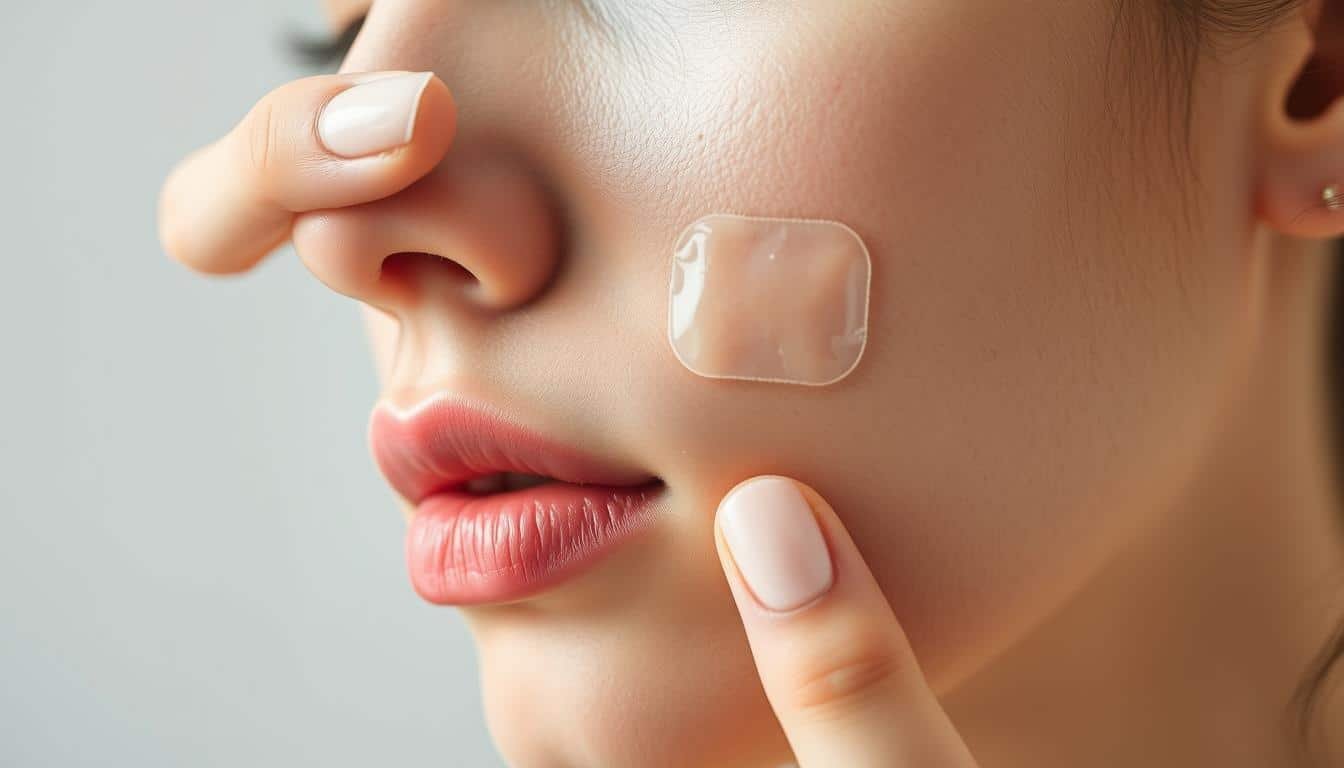Did you know the Mighty Patch Original won the Allure 2020 Best of Beauty Award1? This fact shows how popular and effective acne patches are. They work well on pimples, even after they’ve popped. Putting a patch on a popped pimple can help it heal faster and keep it safe from germs and irritation2.
Acne patches are now a fast and easy way to fight pimples2. They have hydrocolloid gel that pulls out extra oil and dirt3. On a popped pimple, the patch makes a moist space for healing. It also keeps the area clean from outside germs2.
Many articles, videos, and products talk about pimple patches. This shows people are really interested in this new acne treatment1. Whether you have a deep pimple or scars, there’s a patch for you1.
Key Takeaways
- Acne patches can be effectively used on popped pimples to speed up healing and prevent further damage.
- Hydrocolloid material in acne patches absorbs excess fluid, oil, and dirt from the pimple, promoting faster recovery.
- Applying an acne patch on a popped pimple protects the wound from bacteria and irritation, reducing the risk of scarring and hyperpigmentation.
- Choosing the right size patch for your pimple and leaving it on for the recommended time can optimize its effectiveness.
- Some acne patches contain additional ingredients like salicylic acid, niacinamide, or tea tree oil to provide targeted benefits for acne-prone skin.
What Are Acne Patches and How Do They Work?
Acne patches, also known as pimple patches, are small, circular adhesive treatments. They protect pimples from picking and contamination while speeding up healing4. These patches come in two types: hydrocolloid and non-hydrocolloid. The hydrocolloid type is thicker and more effective4.
The main ingredient in most acne patches is hydrocolloid. It’s used in wound care to absorb sebum and dirt, aiding in healing5.
When applied, acne patches stick to the affected area. They absorb excess fluid like oil and dirt, trapping moisture for healing5. Hydrocolloid patches are more effective than non-hydrocolloid ones because of their antibacterial properties6.
Hydrocolloid Material: The Key Ingredient in Acne Patches
Hydrocolloid is the main ingredient in most acne patches. It offers many acne patch benefits. It’s especially good for pimples with yellow pus, as it absorbs excess pus and protects against bacteria5.
In a study, hydrocolloid patches were compared to surgical tape on people with mild to moderate acne. Both groups had less severe acne by the end. The patches were better at controlling redness, oiliness, dark pigmentation, and sebum on specific days6.
“I love using hydrocolloid acne patches! They work wonders in absorbing excess fluid and helping my pimples heal faster without leaving any scars behind.”
Absorbing Excess Fluid, Oil, and Dirt from Pimples
Acne patches absorb excess fluid, oil, and dirt from pimples. This is key for healing. By drawing out these impurities, the patches reduce inflammation and prevent bacterial growth. Some ingredients that help this process include:
- Salicylic acid: Known for penetrating pores and treating pimples4
- Aloe vera extract: Soothes and calms irritated skin
- Retinol: Promotes cell turnover and reduces scars
- Tea tree oil: Provides antibacterial properties
- Hyaluronic acid: Hydrates and plumps the skin5
When using acne patches, apply them on clean, dry skin. Leave them on for up to 24 hours or until they turn opaque. This means they’ve absorbed debris from the pores5. For the best results, choose the right size patch for your pimple. The COSRX Acne Pimple Master Patch comes in three sizes for different blemish sizes5.
The Benefits of Using Acne Patches on Popped Pimples
Putting an acne patch on a popped pimple has many benefits. It helps your skin heal faster and look better. A study by Johnson & Johnson in 2021 showed that using a pimple patch for a week helped pimples look better. Popped pimples healed faster with hydrocolloid patches than without7.
Pimple patches protect your skin, soak up extra fluids, and keep dirt and bacteria out. This helps your skin heal naturally and lowers the risk of scars8.

Speeding Up the Healing Process
Acne patches are made for pimples with yellow pus to absorb excess pus and prevent infection9. They create a healing environment for your skin. Hydrocolloid, a key ingredient, is great for wound care9.
Wearing an acne patch for 24 hours can make your pimple heal faster and better9.
Protecting the Wound from Bacteria and Further Irritation
Acne patches protect your skin from bacteria, dirt, and your hands. They cover the wound, preventing irritation and infection. Hydrocolloid patches are safe for most skin types7.
Reducing the Risk of Scarring and Hyperpigmentation
Picking at pimples can lead to scars and dark spots. Acne patches keep the area clean and covered. This reduces the risk of scarring and hyperpigmentation.
Some patches have extra ingredients like salicylic acid and aloe vera for better healing. But, patches with benzoyl peroxide or salicylic acid might irritate sensitive skin7.
Using acne patches on popped pimples is safe and effective. It supports natural healing, protects against damage, and lowers scarring risk. Adding acne patches to your skincare routine can make your skin clearer and healthier over time.
How to Properly Apply an Acne Patch on a Popped Pimple
First, clean the area and wash your hands to avoid bacteria. This step is key to making the patch work well10. Pick a patch that fits your pimple well, covering it all and centered.
Press the patch onto dry skin for 15-30 seconds. This helps it stick well. Wear the patch for up to 24 hours or until it turns opaque, showing it’s done its job10.
Cleansing the Area Before Application
Clean the area around the popped pimple well before applying a patch. This removes oil, dirt, and bacteria. Use a gentle cleanser and lukewarm water, then dry with a clean towel. Patches stick best to clean, dry skin11.
Choosing the Right Size Patch for Your Pimple
Acne patches come in different sizes for various pimples. For example, the COSRX Acne Pimple Master Patch has three sizes for effective care12. Choose a size that covers the whole pimple and any redness around it. The right size ensures the pimple is well-protected and the patch works well.
Leaving the Patch on for the Recommended Time
After applying, leave the patch on for the recommended time. This lets it soak up the pimple’s fluids and dirt12. Wearing it for several hours or overnight helps heal the pimple faster10. Most patches should be on for up to 24 hours or until they turn opaque. Using patches regularly helps reduce pimple appearance10.
Proper application of pimple patches aids healing and contributes to clearer, healthier skin10.
By following these steps, you can protect your popped pimple, reduce inflammation, and speed up healing. Remember, while patches are helpful, they’re not a cure for chronic breakouts11.
Additional Ingredients in Some Acne Patches and Their Benefits
Most acne patches use hydrocolloid material to soak up excess fluid, oil, and dirt from pimples13. But, some patches also have extra ingredients to help heal your skin. These ingredients target different parts of acne treatment, like exfoliation and reducing inflammation.

Salicylic Acid for Exfoliation and Unclogging Pores
Salicylic acid is a key ingredient in many acne treatments, including some patches. It’s a beta-hydroxy acid (BHA) that exfoliates the skin, unclogs pores, and removes excess oil. This makes it great for treating acne14. Adding salicylic acid to patches keeps the skin protected and absorbs well.
Niacinamide for Reducing Inflammation and Redness
Niacinamide, or vitamin B3, is found in some acne patches. It’s known for reducing inflammation and redness, soothing the skin and improving its tone14. It also makes the skin texture better and strengthens the skin’s barrier, perfect for sensitive or acne-prone skin.
Tea Tree Oil for Its Antibacterial Properties
Tea tree oil is famous for its antibacterial properties. In acne patches, it fights acne-causing bacteria and reduces inflammation14. This essential oil is a natural choice for those who prefer gentle, non-synthetic treatments.
When picking an acne patch, think about your skin’s sensitivity and what it needs. Some patches, like the COSRX Acne Pimple Master Patch, come in various sizes to tackle different acne spots13. Choosing patches with salicylic acid, niacinamide, and tea tree oil can give you a more complete acne treatment. This way, you can get clearer, healthier-looking skin.
Conclusion
Using acne patches on popped pimples has been a game-changer for me. They not only help pimples heal faster but also protect the skin from more harm. These patches are loved for their ability to get rid of zits, thanks to their popularity on social media15.
The hydrocolloid material in these patches sucks up pus and fluid, creating a perfect healing environment15. They’re best for pimples that have yellow pus showing16.
These patches act as a shield, soaking up extra fluid and helping pimples heal without leaving scars or dark spots. Some patches even have extra ingredients like salicylic acid or aloe vera to make them work better1615. They’re also super easy to use, making them a great alternative to other treatments15.
To get the most out of acne patches, clean the area first, pick the right size, and leave it on for up to 24 hours or until it turns opaque16. With so many options, like the COSRX Acne Pimple Master Patch with three sizes16, you can find the perfect one for your skin.
FAQ
Can I put an acne patch on a popped pimple?
What are acne patches made of?
What are the benefits of using an acne patch on a popped pimple?
How do I properly apply an acne patch on a popped pimple?
Do acne patches contain any additional beneficial ingredients?
Source Links
- Pimple Emergency? Here’s How to Use a Pimple Patch – https://www.herocosmetics.us/blogs/news/how-to-use-a-pimple-patch
- Should I Put a Pimple Patch on a Popped Pimple? – https://fazitbeauty.com/blogs/learn-more/should-i-put-a-pimple-patch-on-a-popped-pimple
- Pimple Patch 101: The Do’s and Don’ts of Pimple Patches – https://wishtrend.com/blogs/glam/pimple-patch-101-the-dos-and-donts-of-pimple-patches?srsltid=AfmBOoqOz86zVGO1Xm_G10L0bSt6MaUqIcv3z8vTd9p7Q42vRFbvyQRM
- Acne Patches: Dr. Pimple Popper’s Guide – https://slmdskincare.com/blogs/learn/acne-patches-dr-pimple-poppers-guide?srsltid=AfmBOoq4UKacVLqteFhbu-2ZleHkBquZuzcEab8vUlv5JFymJxECcwkx
- Pimple Patch 101: The Do’s and Don’ts of Pimple Patches – https://wishtrend.com/blogs/glam/pimple-patch-101-the-dos-and-donts-of-pimple-patches?srsltid=AfmBOoqVSyZTI72eAwtWpNhsJ9Kz4HveU_9RD-dTxnYckO7WAFyqJwgY
- What Are Hydrocolloid Patches for Pimples? – https://www.webmd.com/skin-problems-and-treatments/acne/what-are-hydrocolloid-patches-for-pimples
- Do Pimple Patches Work? – https://www.verywellhealth.com/do-pimple-patches-work-7504785
- Understanding Pimple Patches: A Comprehensive Guide | BHSkin – https://bhskin.com/blog/understanding-pimple-patches-a-comprehensive-guide/
- Pimple Patch 101: The Do’s and Don’ts of Pimple Patches – https://wishtrend.com/blogs/glam/pimple-patch-101-the-dos-and-donts-of-pimple-patches?srsltid=AfmBOoowXiai8TpirwA4mUPAf0nPYKoNzdXFZvAMY34FzC4lYdcrlGIO
- Can You Put a Pimple Patch on a Popped Pimple & Will it Work? – https://www.thesuperdots.com/blogs/news/can-you-put-a-pimple-patch-on-a-popped-pimple
- Acne Patches: Dr. Pimple Popper’s Guide – https://slmdskincare.com/blogs/learn/acne-patches-dr-pimple-poppers-guide?srsltid=AfmBOorqfoHfpMvI0ZIZciaCvKSR4bBEeclW_Bt8xaNHGe7O_pyEZpTT
- Pimple Patch 101: The Do’s and Don’ts of Pimple Patches – https://wishtrend.com/blogs/glam/pimple-patch-101-the-dos-and-donts-of-pimple-patches?srsltid=AfmBOorpG5vKwpk_KsZmog4-74plcJSwsLEGH4eoucvq4KiX4eh4FthJ
- Pimple Patch 101: The Do’s and Don’ts of Pimple Patches – https://wishtrend.com/blogs/glam/pimple-patch-101-the-dos-and-donts-of-pimple-patches?srsltid=AfmBOoowoKUY_Xsf133Fsha5GKM7ittH3YDmWD8FzybXQD-XPzcEfIkt
- Pimple Patches and What They Offer – American Chemical Society – https://www.acs.org/education/chemmatters/articles/pimple-patches-and-what-they-offer.html
- Are Pimple patches worth the hype? – https://thedeconstruct.in/blogs/acne/are-pimple-patches-worth-the-hype?srsltid=AfmBOooNHagvSfh0PwefbXhWLqO5aNmQVnW53MmiqGpDKrx6-8xZAZNu
- Pimple Patch 101: The Do’s and Don’ts of Pimple Patches – https://wishtrend.com/blogs/glam/pimple-patch-101-the-dos-and-donts-of-pimple-patches?srsltid=AfmBOoq8dtXle0cZKMkXC6vPdDQR2e0URiYvQbhJiR_5NHGG9B-j5C4R








Honestly, why not just let nature take its course? This obsession with acne patches seems like a marketing gimmick to me.
Interesting read, but isnt popping pimples a big no-no? Shouldnt we be discouraging this instead of finding quick fixes post-pop?
Popping pimples can be unavoidable temptation. Quick fixes post-pop are then essential.
Interesting read, but honestly, wouldnt a good old fashioned astringent work just as well as these fancy acne patches? Just a thought.
But what if popping the pimple is part of my stress relief routine? Worth the scar, dont you think? 😂🤷♀️ #PimplePopper4Life
Interesting article, but arent acne patches just glorified stickers? Why not just wash your face regularly and eat healthier?
So, Im just wondering, if acne patches absorb oil and dirt, could they potentially work as a makeshift blotting paper?